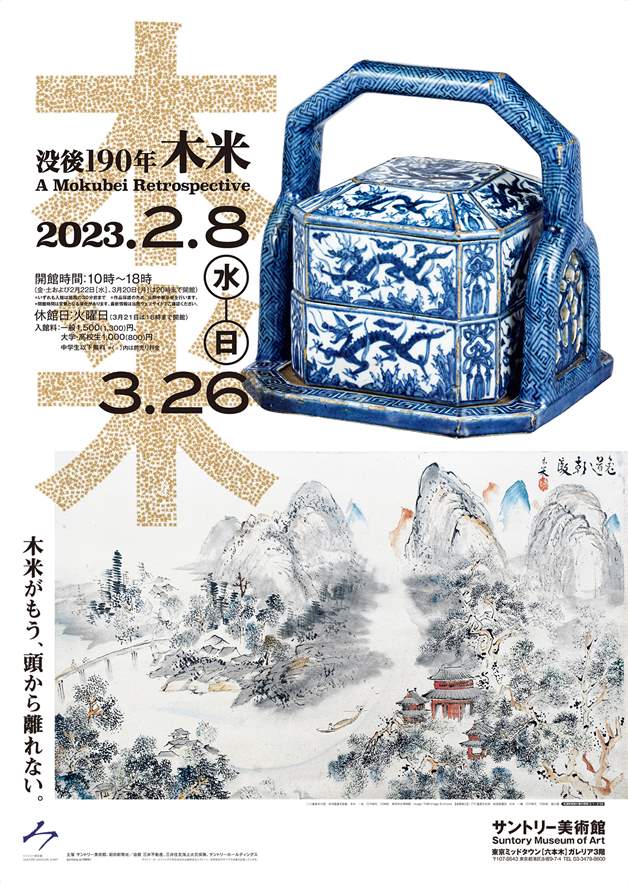Mokubei (1767~1833), a potter and painter who represented Kyoto in the late Edo period, was born in the teahouse "Kiya" in Gion, Kyoto, and is popularly known as "88". It was named "Kime" after the "tree" of Kiya or Mr. Aoki and the "rice" that is a contraction of eighty-eight. In addition to "Deaf Rice", which is derived from being deaf in middle age, there are issues such as "Dragon Rice", "Nine Scales", "Qingli", "Hundred Six Mountain People", and "Ancient Ware".
In his 30s, he came across a Chinese ceramic book, "Ceramic Theory," which he transcribed and devoted himself to the ceramics industry in earnest. His works range from excellent sencha ware to tea ceramics. Based on his diligent research on ancient ceramics, he has a broad perspective, and the creativity of connecting the beauty and beauty of ancient ceramics from ancient and modern times beyond conventions and opening up new beauty is manifested in Kimai pottery.
On the other hand, the paintings that Kime painted energetically, especially from his late 50s, are attractive for their pure and free-spirited style. Many of them are mountain and water maps that were gifts to friends, and if you look at them while imagining their friendships and Kime's own personality, you will feel even more flavorful.
Now, what is indispensable for knowing the literati and wood rice is his magnificent testament. He is said to have said, "I want you to knead the clay from all over the places you have collected so far, put my body in it, burn it in a kiln, and bury it in the mountains.
In this exhibition, we will introduce one of the best masterpieces full of individuality of wood rice that was admired by the literati of the time. Through the ceramics, paintings, and friendships of wood rice, it is a rare opportunity to experience the rare life and the whole picture of wood rice art.
| Phone | 03-3479-8600 |
|---|---|
| Hours | 10:00~18:00(Fri & Sat 10:00~20:00) *Open until 8pm on February 22 (Wed) and March 20 (Mon) *Last admission 30 minutes before closing. *Opening hours are subject to change. |
| Holiday | Tuesday *Open until 6 p.m. on March 21 |
| Transportation | ・Toei Subway Oedo Line Directly connected from Roppongi Station Exit 8 ・Tokyo Metro Hibiya Line Directly connected from Roppongi Station via underground passage ・Tokyo Metro Chiyoda Line About 3 minutes walk from Nogizaka Station Exit 3 ・Toei Bus (Shibuya departure) Toei 01 "Roppongi Ekimae" get off at "Roppongi Station" and walk about 2 minutes ・Chibasu (Akasaka Route) "Roppongi 7-chome", get off at "Hinokicho Park" and walk about 1 minute |
| Admission | 【General】Same day ¥1,500、Advance ¥1,300 【University and High School Students】Same day ¥1,000, Advance ¥800 * Free for junior high school students and younger * If you have a disability certificate, only you and one caregiver are free of charge. [Ticket Sales Location] Suntory Museum of Art reception (Tuesdays, except during exhibition change periods) Suntory Museum of Art Official Online Ticket Lawson Ticket: L code 31763 (advance tickets, same-day tickets) Seven tickets: Seven code 098-104 (advance tickets, same-day tickets) *Advance sale period is from November 30 (Wed) to February 7 (Tue) *Advance ticket sales at the Suntory Museum of Art reception are limited to opening days until Sunday, January 22. * The ticket system may be suspended during the year-end and New Year holidays. Please contact each ticket sales company for the sales schedule. |
| URL | http://suntory.jp/SMA/ |




